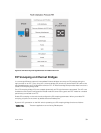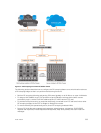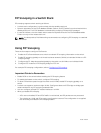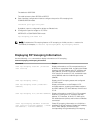
FIP Snooping in a Switch Stack
FIP snooping supports switch stacking as follows:
• A switch stack configuration is synchronized with the standby stack unit.
• Dynamic population of the FCoE database (ENode, Session, and FCF tables) is synchronized with the
standby stack unit. The FCoE database is maintained by snooping FIP keep-alive messages.
• In case of a failover, the new master switch starts the required timers for the FCoE database tables.
Timers run only on the master stack unit.
NOTE: As a best practice, Dell Networking recommends not configuring FIP Snooping on a stacked
MXL switch.
Using FIP Snooping
There are four steps to configure FCoE transit.
1. Enable the FCoE transit feature on a switch to maintain FIP snooping information on the switch.
2. Enable FIP snooping globally on all virtual local area networks (VLANs) or individual VLANs on a FIP
snooping bridge.
3. Configure the FC-Map value applied globally by the switch on all VLANs or an individual VLAN.
4. Configure FCF mode for a FIP snooping bridge-to-FCF link.
For a sample FIP snooping configuration, refer to Configuring FIP Snooping.
Important Points to Remember
• Enable DCBx on the switch before enabling the FIP Snooping feature.
• To enable the feature on the switch, configure FIP Snooping.
• To allow FIP frames to pass through the switch on all VLANs, enable FIP snooping globally on a
switch.
• A switch can support a maximum eight VLANs. Configure at least one FCF/bridge-to-bridge port
mode interface for any FIP snooping-enabled VLAN.
• You can configure multiple FCF-trusted interfaces in a VLAN.
• When you disable FIP snooping:
– ACLs are not installed, FIP and FCoE traffic is not blocked, and FIP packets are not processed.
– The existing per-VLAN and FIP snooping configuration is stored. The configuration is re-applied
the next time you enable the FIP snooping feature.
354
FCoE Transit


















